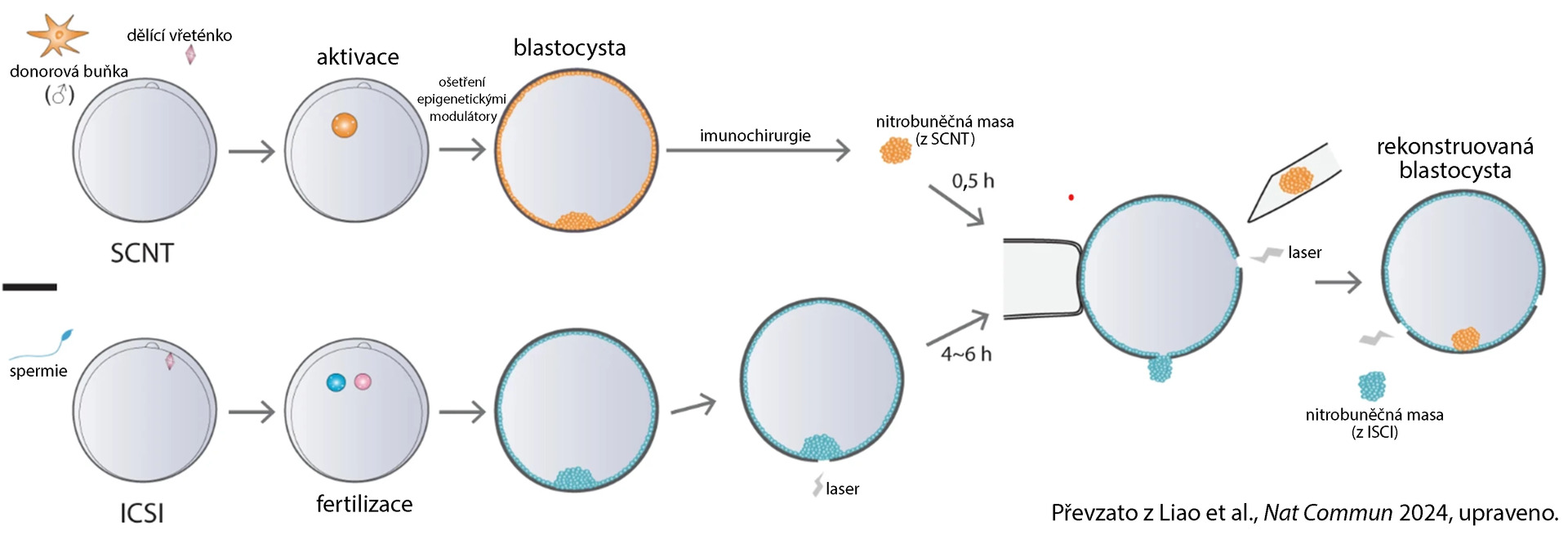A Cloned Monkey Survived to Adulthood for the First Time. Will We Soon Be Able to Clone Humans?
A macaque named ReTro, born as a result of a cloning experiment by Chinese scientists, has reached adulthood. This is the first such successful cloning that could pave the way for further primate research. What is behind the scientists' success? And does this mean we could successfully clone humans?
Low Survival Rate of Clones
The standard cloning technique, which was used for the first mammalian cloning with Dolly the sheep, utilizes somatic cell nuclear transfer (SCNT). Simply put, the isolated nucleus of an adult somatic cell (e.g., skin, liver, or fat) is transferred into an egg that has had its nucleus removed, and this egg is then implanted into a surrogate mother. However, this process results in an extremely low number of born and surviving cloned embryos.
The success rate is particularly low for primates; specifically for rhesus macaques, no viable SCNT individual existed until now. In 2022, scientists managed to bring a clone to birth, but the newborn died within 12 hours. When scientists cloned long-tailed macaques in 2018, they created 109 cloned embryos and implanted nearly three-quarters of them into 21 surrogate mothers, resulting in only 6 pregnancies and only 2 surviving the birth.
Differences in Epigenetic Modifications
Researchers from the Chinese Academy of Sciences in Shanghai decided to compare 484 SCNT-prepared rhesus macaque embryos with 499 embryos created through standard in vitro fertilization (ICSI), where sperm is directly injected into the egg. Both types of embryos went through similar developmental stages before implantation into surrogate mothers. However, implantation was successful in only 35 SCNT embryos (compared to 74 ICSI embryos), and even fewer SCNT fetuses survived until birth.
Scientists then conducted extensive genetic analysis of SCNT embryos, revealing significant differences in epigenetic modifications. These modifications adjust gene activity without changing the DNA structure, such as DNA methylation or histone acetylation. Specifically, DNA methylation was reduced in SCNT embryos. Imprinting loss also occurred (normally, some genes from the father and mother express differently during development), particularly in placental tissue. Additionally, histological examination of SCNT placentas showed noticeable hyperplasia and calcifications.
Adjusting the Placenta as a Solution
Researchers decided to replace the trophoblast (the outer cell layer of the early embryo from which a large part of the placenta develops) of SCNT embryos with a healthy trophoblast from ICSI-prepared embryos. Subsequently, SCNT embryos developed some form of natural placenta, but the fetus remained a cloned embryo.
Diagram showing the procedure for exchanging the trophoblast between monkey blastocysts prepared with ICSI and SCNT techniques

This method enabled the preparation of 113 embryos, 11 of which were implanted into 7 surrogate mothers. The result was 2 pregnancies, one of which produced the macaque ReTro, who has lived for over 2 years. The other surrogate mother carried twins, but they died on the 106th day of pregnancy.
It was demonstrated that trophoblast exchange reduced placental and DNA methylation defects. However, the overall process efficiency is still lower than standard SCNT.
Why Clone Macaques at All?
Since cloning the first primate using SCNT 6 years ago, these monkey models have been used to study diseases such as depression and anxiety, and to evaluate the efficacy and safety of medicines, including antidepressants. This effort aims to use as few animals as possible to prove the effectiveness of drugs without genetic interferences. The cloning process still involves too many obstacles, and despite recent advances, cloning efficiency issues remain unresolved.
What About Humans?
As Dr. Lluís Montoliu from the Spanish National Biotechnology Center stated, the experiment showed that while cloning primates is possible, achieving success is extremely difficult, practically excluding human cloning. Moreover, similar procedures would not be permitted within the EU territory. European legislation excludes the use of primates for scientific purposes unless it concerns life-threatening diseases of humans or primates themselves.
Prof. Robin Lovell-Badge from the British Francis Crick Institute added that the reported method by Chinese scientists does not bring us closer to reproductive human cloning. He said, "It would be unethical purely for safety reasons. And why would anyone want to clone a specific person? The clone might resemble the somatic cell donor in appearance (similar to identical twins, who are usually easily distinguishable), but would not have the same character because we are not just products of our genes."
The authors of the study suggest exploring the potential of trophoblast exchange for assisted reproduction techniques in cases where human embryos exhibit trophoblast developmental deficiencies.
(kata, este)
Sources:
1. Liao Z., Zhang J., Sun S. et al. Reprogramming mechanism dissection and trophoblast replacement application in monkey somatic cell nuclear transfer. Nat Commun 2024 Jan 16; 15 (1): 5, doi: 10.1038/s41467-023-43985-7.
2. Naddaf M. Nature Magazine. Meet ReTro, the first cloned rhesus monkey to reach adulthood. Scientific American, 2024 Jan 17. Available at: www.scientificamerican.com/article/meet-retro-the-first-cloned-rhesus-monkey-to-reach-adulthood
3. Lovell-Badge R., Montoliu L. Expert reaction to study reporting that Chinese researchers have successfully cloned a rhesus monkey. Science Media Center, 2024 Jan 16. Available at: www.sciencemediacentre.org/expert-reaction-to-study-reporting-that-chinese-researchers-have-successfully-cloned-a-rhesus-monkey
Did you like this article? Would you like to comment on it? Write to us. We are interested in your opinion. We will not publish it, but we will gladly answer you.
News from the world of medicine
All conferences
Popular this week
- How Compassion Fatigue Threatens Doctors and Other Healthcare Workers
- A device the size of a matchbox will help treat obstructive sleep apnea
- Good, Bad, or Ugly? What's the Deal with Eggs?
- Non-Invasive Analysis of Gut Microbiome Biomarkers Enhances Diagnosis of IBD
- New Algorithm to Enhance Prediction of Cardiovascular Disease Risk
